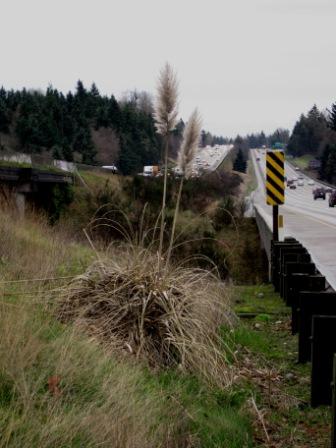Great discussion and answers on this one, gang! Yes indeed, this is a plant out of place – as several of you noted. But not only has it escaped from an ornamental landscape, it’s decided to grow, quite happily, in the median strip of I-5:

Another odd thing is that the species has not been officially recognized as invasive in Washington State. It’s been languishing on the “Monitor” weed list for at least two years. Our climate is a bit chilly for it, which may be part of the reason it looks so bad right now. We had a very cold week back in November which may have killed this specimen back to the crown. But never fear. New growth will emerge this spring. (Note to Washington State weed control board – maybe it’s time to list this plant as invasive???)
Finally, I do believe this specimen was sprayed last spring, as Jimbo pointed out. However, it recovered and was able to send up two seed heads…which I’m sure have lavishly sprinkled the surrounding soil.
I don’t think pampas grass will survive well above hardiness zones 7. and we used to think the plant was monoecious with only plants that had female flowers likely to set seed and be invasive, but that is now known to be false. How warm is it where this plant was spotted? maybe the median is a warm, although harsh micro-climate.
Mary, this strip of I-5 between Seatle and Tacoma is zone 8, more or less. Most of Western Washington – at least the lowlands – is zone 8. That’s why I’m surprised that it’s still not listed yet, since it’s still rather isolated.
Pampas grass survives very easily in Zone 6 VA. Days in the low 30’s and nights in the single digits to below 0 don’t have an adverse effect on growth or bloom.